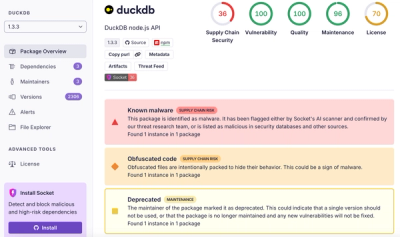
Product
Introducing Tier 1 Reachability: Precision CVE Triage for Enterprise Teams
Socket’s new Tier 1 Reachability filters out up to 80% of irrelevant CVEs, so security teams can focus on the vulnerabilities that matter.
Binary In-Place Format. A binary format designed for in-place (without parsing) reads, with schemaless json-like semantics.
In a database there are many cases where you need to read a bunch of records, filter out most of it (if one or two fields do not match) and then immediately write whats left to a network socket. With json, this means parsing possibly hundreds of thousands of json objects (which is suprisingly slow), and then reserializing whats left. An inplace format doesn't actually require parsing as a whole at all. You only need to parse the fields you actually read, and using length delimited fields instead of escapes, means you do not have to look at every byte to parse a field.
Unfortunately, most binary json-like formats (such as msgpack and cbor) use element counts on collections (objects and arrays, in json-land) this means to find the end of a collection, you have to step past each item in it (including the fields in any object contained inside of it). However, if the collections are length delimited, meaning marked by the encoded byte length of the object, not the number of items inside it, then it's easy to jump right to the end of the object in one go. For this reason, databases (for example, mongodb, and couchdb) use length delimited collections.
The format of BIPF is specificed in the spec.
All values must have a correct length field. This makes it possible to traverse all fields without looking at the values. Theirfor it is possible to quickly jump to any subvalue if you know it's path. If you are looking for a particular string, you can also skip any with the wrong length! Since object and array fields also begin with a length, you can jump past them if you know they do not contain the value you are looking for. This means that seeking inside a more tree like object is more efficient than seeking inside a more list like object!
This design is optimized for the performance of in-place reads. Encoding is expected to be slower because of the need to calculate the length of collections before encoding them. If encoding is within half as fast as a format intended for encoding perf, that is good. Of course, the intention with an in-place read system is that you encode once and then never decode. Just pass around the binary object, reading fields out when necessary.
Because of the length encoding, the ability to update in-place is very limited (not recommended actualy) but if you are building a system around immutable data, that is not much of a problem. Although, since subobjects are fully valid as an encoded value, you can easily copy a subobject into a new object, etc, without re-encoding.
I did a simple benchmark, where I encoded and decoded this module's package.json file in various ways. Please not that I am comparing the performance of code written in C with code written in javascript. If the javascript is within 10x the performance of the C then we are doing well! (and a C implementation would likely close that gap)
The measurement is run 10k operations, then divide by number of ms taken, higher number means more faster!
Benchmark code is in ./test/perf.js
operation, ops/ms
binary.encode 62.61740763932373
JSON.stringify 325.7328990228013
binary.decode 83.40283569641367
JSON.parse 242.13075060532688
JSON.parse(buffer) 198.4126984126984
JSON.stringify(JSON.parse()) 127.55102040816327
binary.seek(string) 500
binary.seek2(encoded) 1219.5121951219512
binary.seek(buffer) 1333.3333333333333
binary.seekPath(encoded) 558.659217877095
binary.seekPath(compiled) 1265.8227848101267
binary.compare() 1785.7142857142858
As expected, binary.encode is much slower than JSON.stringify, but
it's only 6 times worse. But the interesting comparison is
JSON.stringify(JSON.parse()) and binary.seek(buffer). Often, in
implementing a database, you need to read something from disk, examine
one or two fields (to check if it matches a query) and then write it
to network.
(note: the binary.seek operation is fairly realistic, we seek to the
"dependencies" object, then look up "varint" inside of that, then
decode the version range of "varint". So it's two comparisons and
decoding a string out)
So, in JSON land, that usually means reading it, parsing it, checking it, stringifying it again. This involves reading each byte in the input and allocating memory for the parsed object. Then traversing that object in memory and writing something to a string (more memory allocation, and all this memory allocation means the garbage collector needs to handle it too)
But if we have in-place reads, we just read raw binary, seek into the appropiate places to check wether it's the objects we want, and then write it to the network directly. We don't allocate any new memory after reading it.
Further benchmarks and tests are necessary, but that it can be this fast using a javascript implementation is impressive.
For a system with signatures, it's highly important that data is cannonical. There should be exactly one way to encode a given data structure. There are a few edge cases here that need to be checked for. (not implemented yet)
These properties can all be checked by traversing the tags but without reading the keys or values. I will not consider this module ready until there are tests that cover these invalid cases, to ensure that implementations throw an error.
encode, decode, encodingLength follow the interface specified by
abstract-encoding
returns the length needed to encode value
write value to buffer from start. returns the number of bytes
used.
allocate a new buffer and write value into it. returns the newly
created buffer.
same as encode, but tags the buffer as being a bipf buffer, such
that you can place this buffer in another encoded bipf, and it won't
be "double encoded", it will just be embedded inside the larger buffer.
same as allocAndEncode, but tags the resulting buffer as being a
bipf buffer.
Example:
var obj = {address: {street: '123 Main St'}}
var buf1 = bipf.allocAndEncode(obj)
var innerObj = {street: '123 Main St'}
var innerBuf = bipf.allocAndEncodeIdempotent(innerObj)
var outerObj = {address: innerBuf}
var buf2 = bipf.allocAndEncode(outerObj)
deepEquals(buf1, buf2) // true
Counter-example:
var obj = {address: {street: '123 Main St'}}
var buf1 = bipf.allocAndEncode(obj)
var innerObj = {street: '123 Main St'}
var innerBuf = bipf.allocAndEncode(innerObj)
var outerObj = {address: innerBuf}
var buf2 = bipf.allocAndEncode(outerObj)
deepEquals(buf1, buf2) // false
does nothing else but tag the buffer as being a bipf buffer, such
that you can place it in another encoded bipf, and it won't be "double
encoded", it will just be embedded inside the larger buffer.
returns the same buffer as the input.
returns true if buffer received an encodeIdempotent() call or a
markIdempotent() call.
read the next value from buffer at start. returns the value, and
sets decode.bytes to number of bytes used.
reads the value from BIPF-encoded buffer at start, and returns the
encoded value at that pointer, without decoding it.
returns the type tag that will be used to encode this type.
get the type tag at start
an object containing the type tags.
If the field at start is an object or array, then iterate will
call the fn with arguments fn(buffer, pointer, key) for each
subfield. If the field at start is not an array or object, this
returns -1. You can stop/abort the iteration by making fn return
any truthy value.
Seek for a key target within an object. If getEncodedType(buffer, start) !== types.object then will return -1. Otherwise, seekKey
will iterate over the encoding object and return a pointer to where it
starts.
Since this defines a recursive encoding, a pointer to any valid sub-encoding is a valid start value.
var obj = {
foo: 1,
bar: true,
baz: 'hello'
}
//allocate a correctly sized buffer
var length = b.encodingLength(obj)
var buffer = Buffer.alloc(length)
//encode object to buffer
b.encode(obj, buffer, 0)
//parse entire object and read a single value
console.log(b.decode(buffer, 0).baz)
//seek and decode a single value
console.log(b.decode(buffer, b.seekKey(buffer, 0, 'baz')))
See performance section for discussion on the performance of seek - if it's only needed to parse a couple of elements, it can be significantly faster than parsing.
Same as seekKey, except target must be an encoded value. This is
usually done using allocAndEncode. This is a bit faster.
Same as seekKey, but uses a cache to avoid re-seeking the pointers
if the same arguments have been provided in the past. However,
target must be a string, not a buffer.
The same as seekKey, except for a recursive path. path should be
an array of node buffers, just holding the key values, not encoded as
bipf.
Compiles a javascript function that does a seekPath. This is significantly faster than iterating over a javascript array and then looking for each thing, because it will get optimized by the js engine's jit compiler.
MIT
FAQs
binary in-place format
The npm package bipf receives a total of 158 weekly downloads. As such, bipf popularity was classified as not popular.
We found that bipf demonstrated a not healthy version release cadence and project activity because the last version was released a year ago. It has 5 open source maintainers collaborating on the project.
Did you know?

Socket for GitHub automatically highlights issues in each pull request and monitors the health of all your open source dependencies. Discover the contents of your packages and block harmful activity before you install or update your dependencies.

Product
Socket’s new Tier 1 Reachability filters out up to 80% of irrelevant CVEs, so security teams can focus on the vulnerabilities that matter.

Research
/Security News
Ongoing npm supply chain attack spreads to DuckDB: multiple packages compromised with the same wallet-drainer malware.

Security News
The MCP Steering Committee has launched the official MCP Registry in preview, a central hub for discovering and publishing MCP servers.